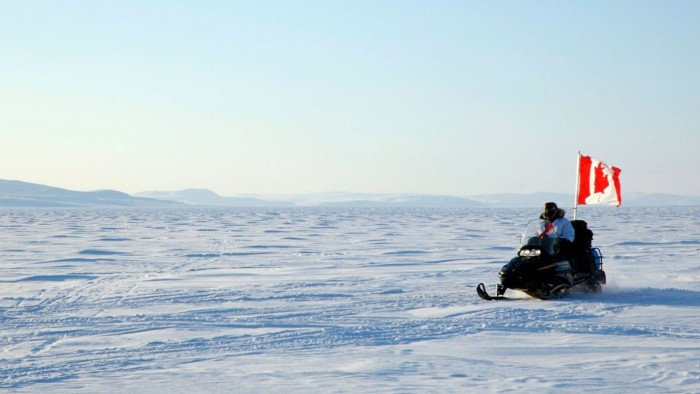In an ever-evolving world, where climate change continues to reshape the planet’s landscapes, the Arctic has emerged as a focal point of international attention. Canada’s role in Arctic sovereignty has taken center stage as nations race to exploit the polar regions for their vast resources and strategic significance. A notable report by Pam Morrissey in “The Aurora” on 26 February 2008 sheds light on these crucial developments, as well as Canada’s efforts to assert its presence in this delicate geopolitical theater.
The Changing Arctic Landscape and Resource Race
The Arctic, long characterized by its frozen expanses and remote isolation, is now experiencing rapid changes due to global warming. The melting ice has led to increased accessibility to the region’s valuable resources, including oil, natural gas, minerals, and fish. This has triggered a rush among nations to secure their interests and claim sovereignty over Arctic territories. Canada, being one of the eight Arctic states, finds itself intricately entwined in this race.
Sustainable Resource Management: Canada’s Approach
Canada’s approach to resource management in the Arctic reflects a commitment to both economic development and environmental preservation. With the potential for increased resource extraction, Canada seeks to balance its economic goals with responsible and sustainable practices. This delicate equilibrium is central to maintaining Arctic sovereignty while minimizing ecological impact.
Canada’s Proactive Approach to Arctic Sovereignty
Pam Morrissey’s report in “The Aurora” highlights Canada’s proactive measures to assert its territorial claims and establish its presence in the Arctic. The need to safeguard its sovereignty and promote responsible resource development has led Canada to invest in research, infrastructure, and diplomatic efforts. The Canadian government recognizes that a strong presence in the region not only reinforces its territorial integrity but also allows it to play a pivotal role in shaping the Arctic’s future.
Arctic Infrastructure Development: A Strategic Imperative
Canada’s commitment to Arctic sovereignty is exemplified by its investments in infrastructure development. As shipping routes become increasingly viable due to melting ice, Canada aims to enhance its capacity to monitor and manage its Arctic territories. The development of research stations, communication networks, and transportation infrastructure underscores Canada’s dedication to maintaining control over this vital region.
Challenges on the Path to Arctic Sovereignty
However, Canada’s pursuit of Arctic sovereignty is not without challenges. As the ice recedes, new shipping routes are becoming available, opening up the possibility of increased maritime traffic. This presents both economic opportunities and environmental concerns. The delicate Arctic ecosystem is susceptible to disruption, and any mismanagement of resource extraction could have irreversible consequences. Balancing economic interests with environmental stewardship is a complex task that Canada and other Arctic nations must navigate carefully.
Eco-Diplomacy and Multilateral Cooperation
Addressing the challenges of Arctic sovereignty requires collaborative efforts among nations. Eco-diplomacy, involving environmentally conscious negotiations, plays a critical role in preventing resource-driven conflicts and ensuring sustainable practices. Canada’s active participation in organizations like the Arctic Council highlights its dedication to diplomatic solutions that prioritize the preservation of the Arctic environment.
Diplomacy and Collaboration in the Arctic
“The Aurora” report also draws attention to the importance of cooperation and diplomacy in the Arctic region. With multiple stakeholders vying for influence, establishing mechanisms for dialogue and collaboration becomes crucial. Canada has engaged in various international forums, such as the Arctic Council, to facilitate discussions on shared challenges and opportunities. These diplomatic efforts aim to prevent conflicts and promote sustainable development in the region.
Indigenous Engagement: A Cultural Diplomacy Approach
Recognizing the significance of Indigenous communities in the Arctic, Canada has employed a cultural diplomacy approach. Collaborative partnerships with Indigenous groups contribute not only to territorial claims but also to fostering mutual understanding and respectful stewardship of the Arctic’s unique cultural and ecological landscape.
Beyond Sovereignty: Addressing Domestic Priorities
In addition to Arctic sovereignty, the report briefly mentions “repairs and equipment for post-secondary institutions.” This serves as a reminder that while the race to exploit the polar regions garners significant attention, it’s essential not to overlook domestic priorities. A well-educated population and strong infrastructure are foundational elements that support a nation’s engagement on the global stage.
Investment in Education and Research: A Holistic Vision
Canada’s commitment to addressing domestic needs reflects its holistic vision for the future. By investing in education and research, particularly in post-secondary institutions, Canada ensures a skilled workforce capable of contributing to various sectors, including those related to Arctic exploration and management. Pam Morrissey’s insightful report in “The Aurora” underscores the multifaceted nature of Canada’s role in Arctic sovereignty. As the polar regions become more accessible due to climate change, the competition for resources and influence intensifies. Canada’s proactive approach to safeguarding its interests, promoting responsible development, and engaging in diplomatic efforts reflects its commitment to maintaining a balanced and sustainable presence in the Arctic. As the world watches the evolving dynamics of the North, it is clear that Canada’s actions will continue to shape the future of this critical region.

